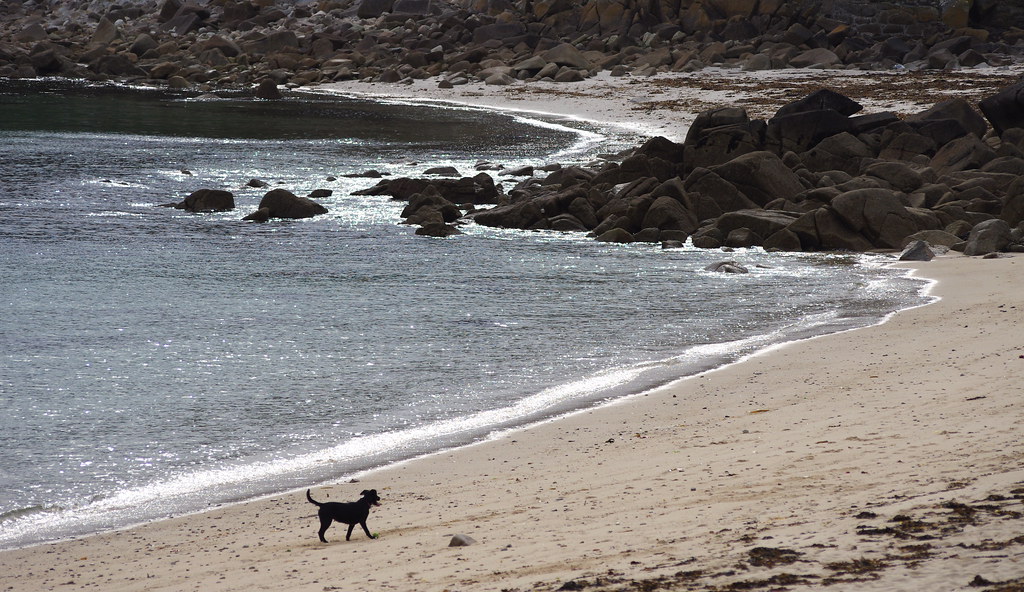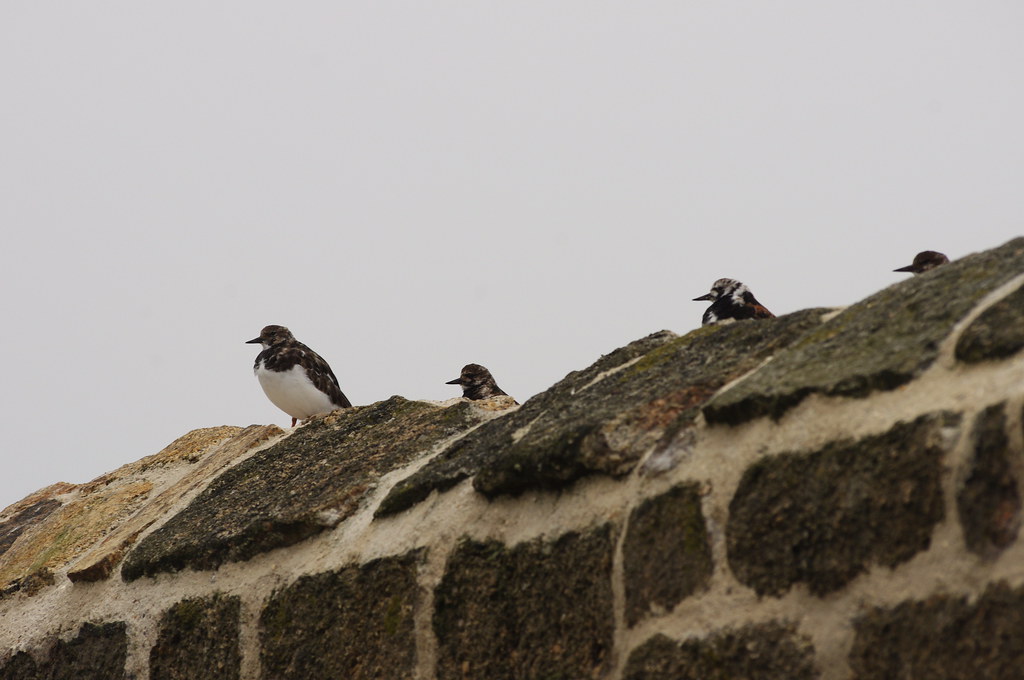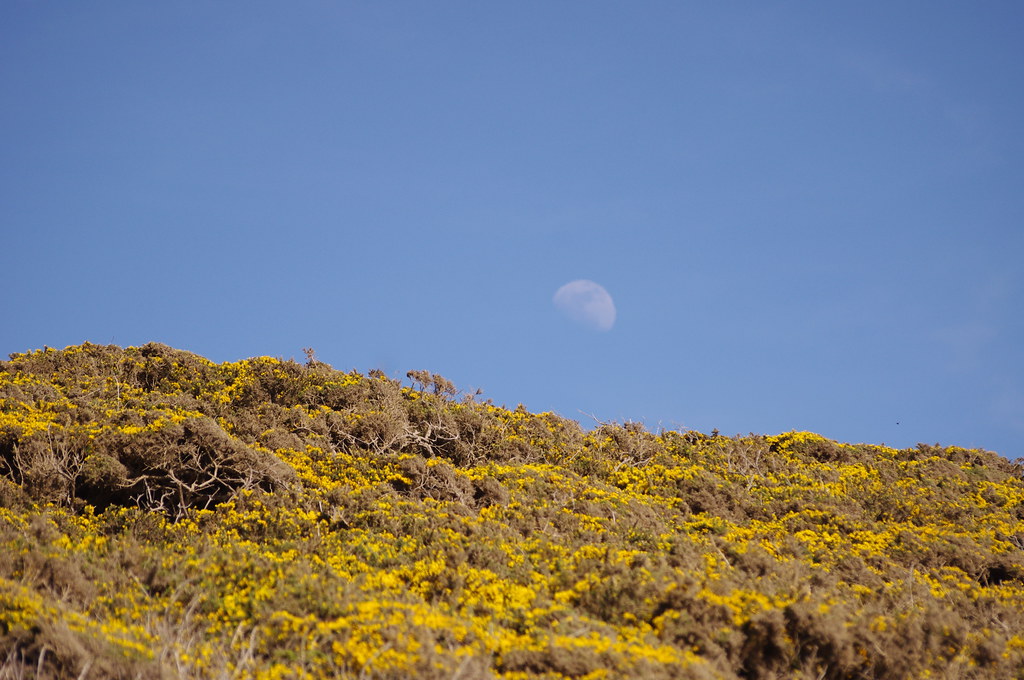 |
| St. Michael's Mount, Penzance |
One huge and wonderful difference this year were the conditions during our trip to the islands. If you read my account of last year's trip, you may recall that the 2012 journey was the most sickening thing I have ever experienced, thanks to the powerful winds and huge swell. This year, the sky was perfectly clear and the sea was amazingly flat, and everyone kept remarking on how it was the most beautiful day that had ever been seen for a crossing. It was truly lovely, though, as always, a bit chilly up on deck--I was shivering despite being thoroughly bundled. I was also incredibly drugged; I wasn't taking any chances with motion sickness, so I popped a Dramamine before every aquatic outing and therefore spent quite a bit of time feeling dopey (but not nauseous!).
Our arrival on the Isles coincided with the last few days of the moon's waxing, which gave us some incredible views and allowed me to take one of the most beautiful photos I've ever taken--though this says less about my own talents than it does about the insane beauty of the Cornish landscape:
The only problem with the increasingly full moon was that it obscured the Lyrid meteor shower on the couple cloudless nights we experienced during our stay on the Isles. Nevertheless, to my great excitement, I did manage to see a single, blue-tinged meteor go streaking across the sky. This was actually a pretty big feat because even though the Lyrid event can bring hundreds of meteors per hour during its peak, they are often quite faint--especially when there is a giant full-ish moon in the sky. I got lucky because there was some partial cloud cover that intermittently covered the moon and allowed me to see the other celestial bodies more clearly. While stargazing, I also managed to see several satellites zipping past, though sadly I was unable to get a glimpse of the International Space Station (with which I have become a bit obsessed after beginning to follow Commander Hadfield's space-based Twitter feed).
 |
| Daisies and lesser celandine decorated the lawn near the Garrison |
This year, the students started their research projects right away, giving the staff almost two full days of alone time before we did any group activities. I did quite a lot of grading each day, but I also took advantage of the opportunity to hike around the island and look for wildlife. Thanks to changing weather patterns, the Scillies have looked different each time I've visited. On one of my first couple journeys, a mild winter had ushered in an early spring, and I can clearly recall the masses of beautiful pink thrift in bloom everywhere I looked. As the winters have gotten harsher and longer over the past two years, the thrift has bloomed later and later; this year there was only a handful of flowers and buds, with most of the plants still in hibernation. Instead of pink, the islands were dominated this time around by yellow--mostly the yellow of gorse and lesser celandine. It is amazing how different everything looks and feels with different things in bloom.
The other huge ecological difference this year was the lack of auks seen during our boat trip out to the Western Rocks. Puffins in particular were quite scarce; we saw a couple during our ferry ride to St. Mary's, but none were seen subsequently (to the great disappointment of the students). We did see a few guillemots and razorbills, but nothing like the numbers encountered previously. Here's a visual to help you see the disparity:
I hope this pattern stems only from differences in weather; if so, the birds are likely just delaying their migration by a few weeks because they're waiting for conditions to become more favorable in the Scillies. However, thousands of seabirds died off the southern coast of Britain this winter after a ship illegally dumped some sort of sticky oily substance in the Channel. Thus, it is also possible that the Scillies has low numbers of auks because many of them perished after becoming coated with pollution. Pointless, unnecessary, and utterly sickening.
 |
| A dog frolics on Porthcressa Beach, St. Mary's, Isles of Scilly |
On a happier note, there are a few places I always visit when hiking around St. Mary's; I'm particularly fond of the wetland areas and their waterfowl hides. This year I was massively excited to spot two snipes--birds that I haven't seen for at least a decade. There was also a beautiful pair of pintails, and an egret that strode around confidently snatching up a seemingly endless supply of fish from one of the small ponds. In order to get a little variety, I visited some of the island's Bronze Age and Iron Age ruins, which I'd previously glimpsed from the boat but never seen up close.
 |
| Bant's Carn, St. Mary's, Isles of Scilly |
Part of the reason I headed to the ruins was that they were in the vicinity of the telegraph tower, which was the location of a recent shrike sighting. I was never able to find the elusive bird, though I saw a good many old burial chambers and hiked along a large section of the coast that I had never visited. During the several hours that I spent wandering around the northwestern portion of the island, I encountered maybe a half dozen other people; mostly, it was just me, the birds, and the wildflowers--pretty heavenly. I discovered all sorts of sandy beaches that I didn't even know existed on St. Mary's, and got good views of Tresco and St. Martin's not far off the coast of the island.
 |
| One of St. Mary's "hidden" beaches, with Tresco and St. Martin's islands off in the distance |
The one thing that bothered me about all this hiking was how poorly marked the area was. There were really clear signposts to the various ruins, but then nothing else was labeled. There were bits where I couldn't tell the difference between the coastal path and someone's private road, and at no point could I clearly tell how on earth to get back to Hugh Town. I was beginning to think that I might have to circumnavigate the entire island just to get home. On a whim, I decided to take a random path inland and just follow my inner compass; luckily, it got me where I needed to go without any ridiculous detours. In the process, I was able to see even more portions of the island that I'd never encountered before--the predominantly non-touristy areas where the Scillonians actually live. I was left feeling very jealous.
 |
| Mallards, domestics, and mallard-domestic hybrids hang out by the side of a little-used road |
My least favorite part of the Scillies trip is usually the rock pooling trip during which we teach the students about different tidal zones and adaptations allowing organisms to survive periodic exposure to sunlight, air, and saltwater. In general, I love looking at wildlife and learning new species, but I struggle with this particular exercise. For one thing, I have a (ridiculous) hangup about seaweed--namely, I do not want it to ever touch any part of my body (except when it is in sushi format, in which case it may touch my mouth and stomach). I also hate the idea of sticking my hand down into a rock pool and blindly fishing around for something to grab onto (are you crazy? there are crabs down there!). Also--perhaps most importantly of all--I hate trying to balance on top of slippery, wet, algae-covered boulders; it really hurts my knees and one day I know I'm going to fall and break something.
There is, however, a big part of me that would like to just get over these hangups and have fun with this activity. I love being able to recognize wildlife, and there are so many tidal species to see and learn--not to mention that many of them are edible and can make valuable contributions to one's diet! In the spirit of adventure and education, I tried to get more enthusiastic about the rock pooling this year, and, as a result, I did end up having a much better time with it. The students found some really interesting species, including one of my favorites: a pipefish.
 |
| Worm pipefish |
We almost made it through the entire trip without any major drama, but on one evening a huge fight broke out amongst some non-Exeter people at the far side of our campsite. One of the campers involved in the dispute shoved her two young children at a group of our students that happened to be nearby at the time, asking them to get the kids out of harm's way. This motivated our trip leader, Frank, to wade in to try to settle the argument and get our students as far away from it all as he could. Although Frank was the embodiment of reason and peace, he ultimately had to call the entire St. Mary's police force (all two of them!) to come mediate. The entire drama lasted for about three hours and was the topic of quite a lot of Scilly gossip the following morning. The speed with which news of this event reached everyone's ears was a perfect reminder of how small St. Mary's really is.
Other than that minor wrinkle, the trip went about as smoothly as we could have hoped for. The clouds unexpectedly parted during the students' presentations on the final afternoon, so we sat bathed in sunlight as we wrapped up our last few official orders of business. The fog descended again during our ferry ride back to the mainland, but was not so thick that it prevented us from seeing several pods of common dolphins out in the open ocean, and another pod of bottlenose dolphins near the Penzance harbor. The water was, again, quite calm--so calm that we arrived 45 minutes ahead of schedule. We were all pretty chilly while waiting for the bus to pick us up, but at least we had these guys to keep us amused:
 |
| Turnstones keeping watch along the Penzance pier |
One day I'm hoping to return to the Scillies as a non-academic visitor and explore bits of the archipelago that we don't have a chance to see with the students. For now, though, I'm more than happy to earn my trip by pointing out wildlife and chatting about animal behavior. It's hard to believe that such an enjoyable experience could be considered work!


No comments:
Post a Comment